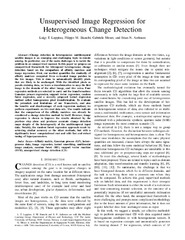Unsupervised Image Regression for Heterogeneous Change Detection
Permanent link
https://hdl.handle.net/10037/17764Date
2019-08-14Type
Journal articleTidsskriftartikkel
Peer reviewed
Abstract
Change detection (CD) in heterogeneous multitemporal satellite images is an emerging and challenging topic in remote sensing. In particular, one of the main challenges is to tackle the problem in an unsupervised manner. In this paper, we propose an unsupervised framework for bitemporal heterogeneous CD based on the comparison of affinity matrices and image regression. First, our method quantifies the similarity of affinity matrices computed from colocated image patches in the two images. This is done to automatically identify pixels that are likely to be unchanged. With the identified pixels as pseudotraining data, we learn a transformation to map the first image to the domain of the other image and vice versa. Four regression methods are selected to carry out the transformation: Gaussian process regression, support vector regression, random forest regression (RFR), and a recently proposed kernel regression method called homogeneous pixel transformation. To evaluate the potentials and limitations of our framework and also the benefits and disadvantages of each regression method, we perform experiments on two real data sets. The results indicate that the comparison of the affinity matrices can already be considered a CD method by itself. However, image regression is shown to improve the results obtained by the previous step alone and produces accurate CD maps despite of the heterogeneity of the multitemporal input data. Notably, the RFR approach excels by achieving similar accuracy as the other methods, but with a significantly lower computational cost and with fast and robust tuning of hyperparameters.
Is part of
The published version of this article is part of Luigi Tommaso Luppino's Ph.D. thesis, available in Munin at https://hdl.handle.net/10037/18399Publisher
IEEE (Institute of Electrical and Electronical Engineers)Citation
Luppino, L.T; Bianchi, F.M.; Moser, G.; Anfinsen, S.N. (2019) Unsupervised Image Regression for Heterogeneous Change Detection. IEEE Transactions on Geoscience and Remote Sensing, 57, (12), 9960-9975.Metadata
Show full item recordCollections
© Copyright 2020 IEEE - All rights reserved


 English
English norsk
norsk